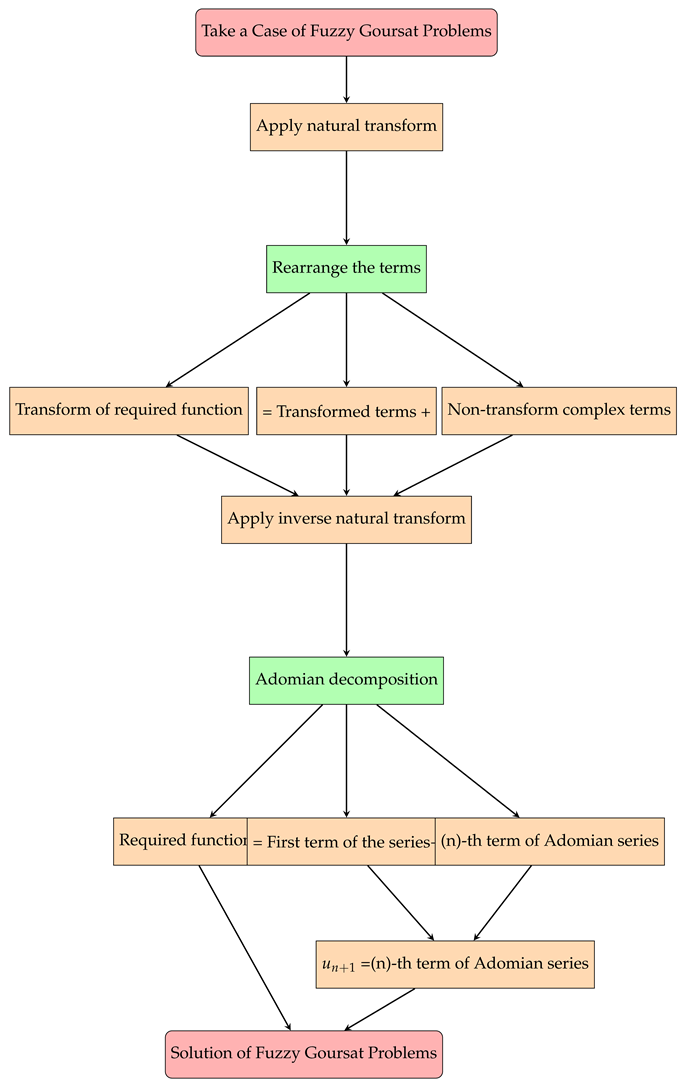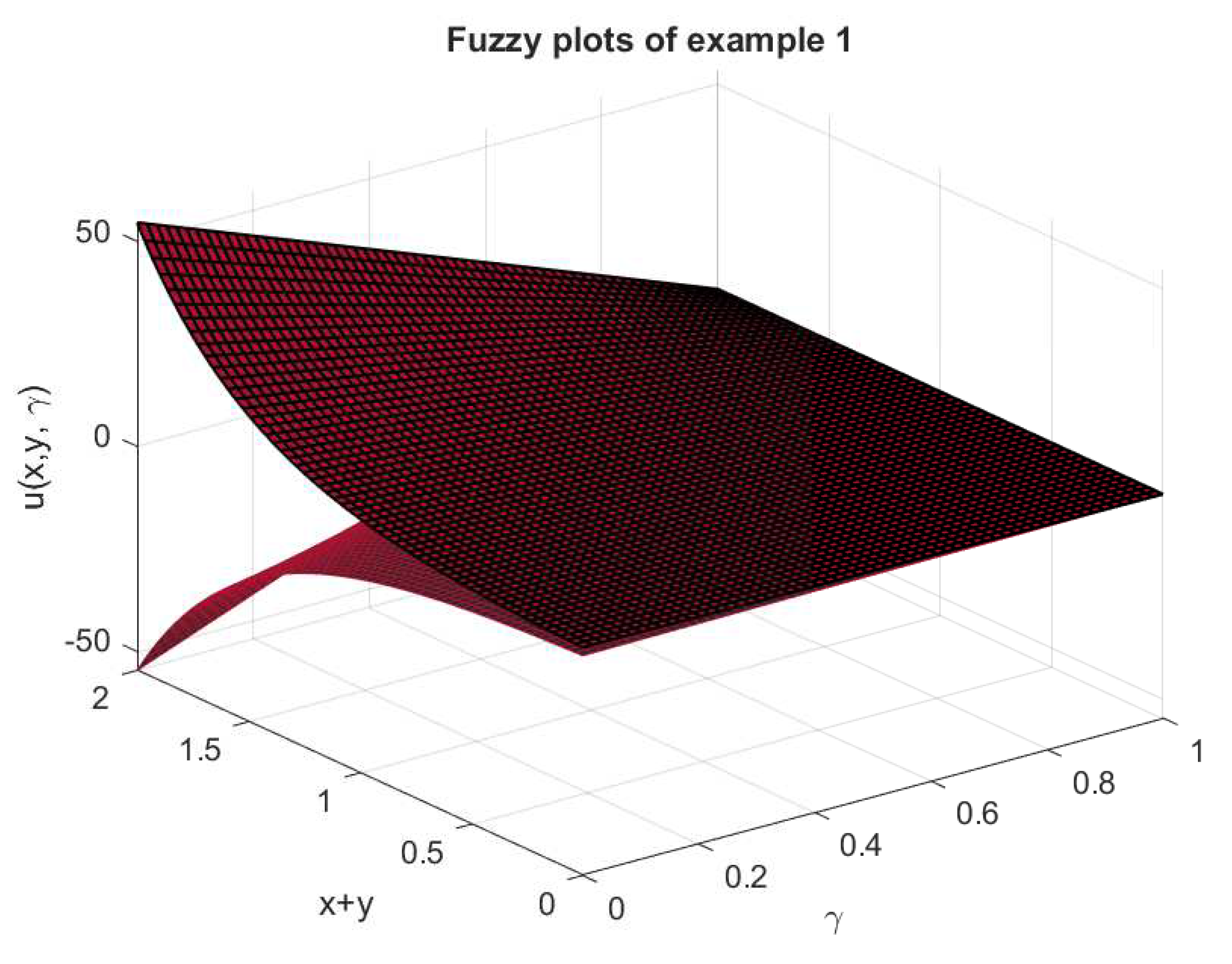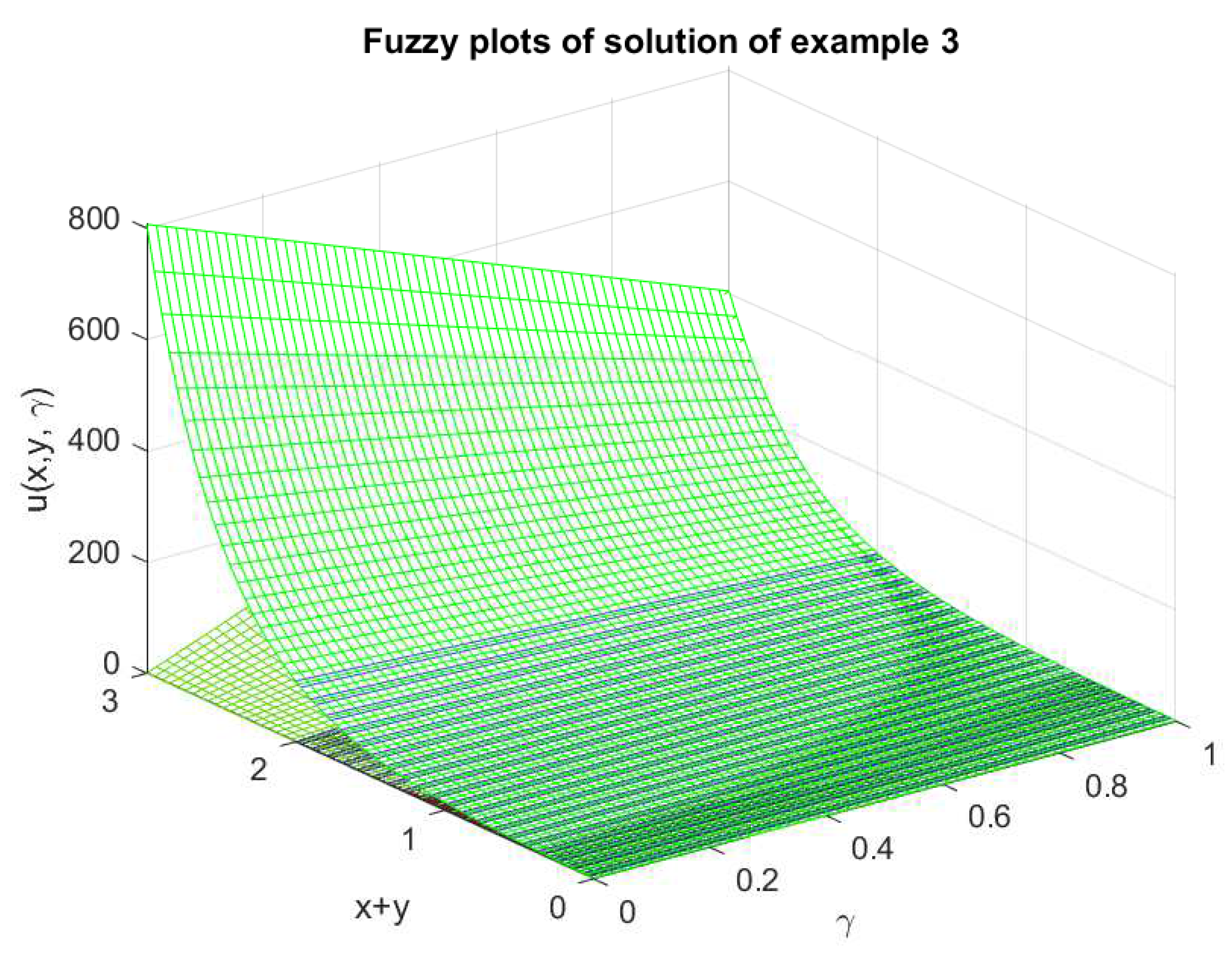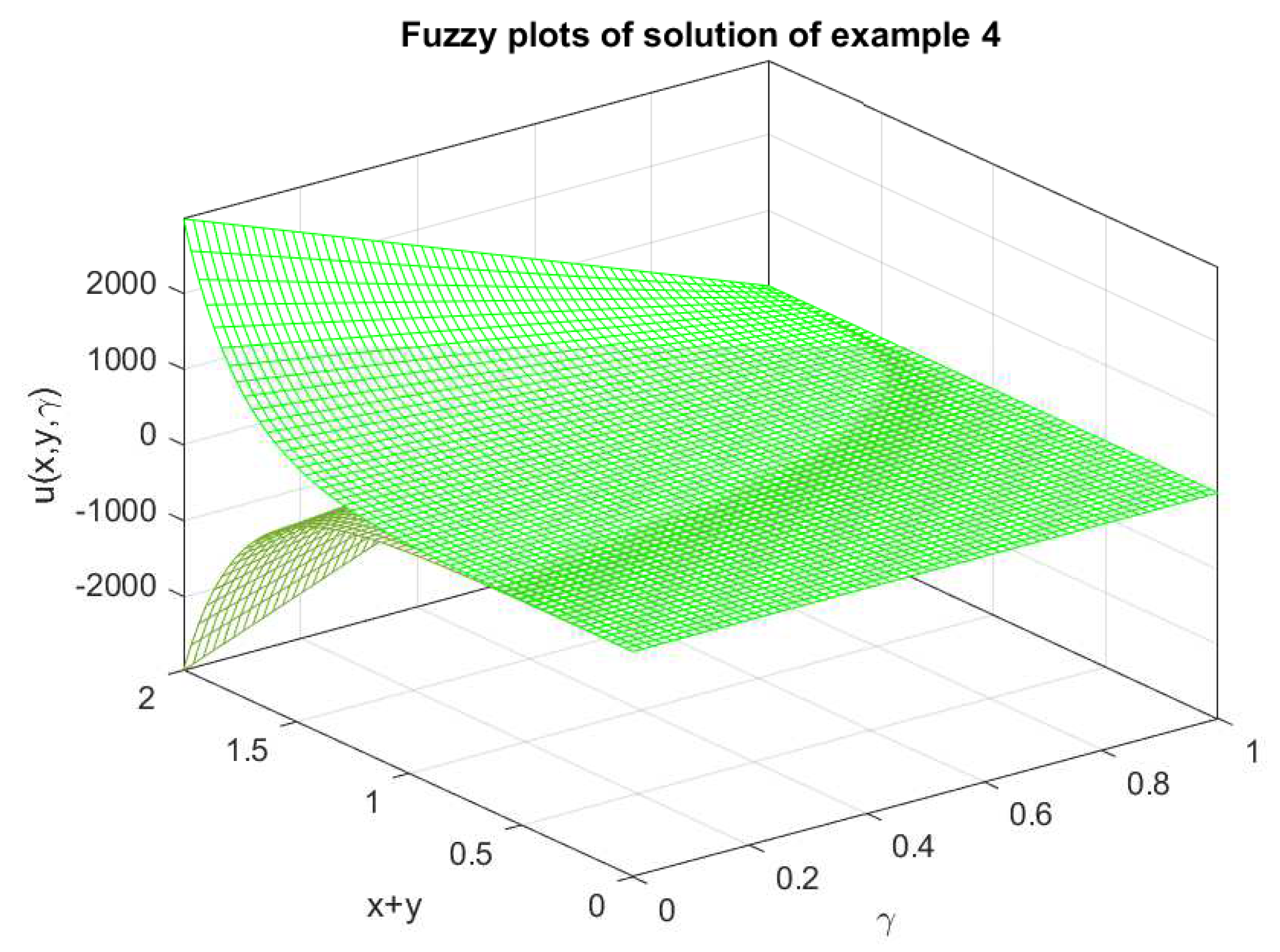1. Introduction
Fuzzy calculus has valuable applications in many physical problems, particularly those involving uncertainty [
1]. It also has important contributions in other fields like banking [
2], optimization [
3], resources allocations [
4], decision-making [
5], linear programming and engineering. In fuzzy calculus, ordinary and partial fuzzy differential equations have an important role. But in the phenomena of the physical world, several independent variables are involved, and therefore partial differential equations perform better than ordinary differential equations. In the physical world, any physical measure contains uncertainty. Buckley and Feuring [
6] used the concept of fuzziness to address uncertainty in partial differential equations. After this work, the concept of fuzzy partial differential equations has been used by many researchers for different processes such as heat equations [
7,
8], advection equations [
9], advection-diffusion equations [
10,
11] and fractional differential equations [
12].
In wave phenomena, hyperbolic partial differential equations have second-order mixed derivative terms, these problems are known as Goursat problems. Goursat problems have many applications in physics, engineering and other fields. The authors of [
13,
14,
15,
16] discussed some applications and solution methods for Goursat problems. In paper [
17], the authors discussed the conditions for Goursat problems with fuzzy boundary conditions to ensure unique solutions.
The existing literature has various processes to solve differential equations (DEs) such as integral transforms (Laplace, Sumudu, natural transform, etc.) and series processes (Taylor’s series, Adomian decomposition, Homotopy, etc.). George Adomian [
18] was the first one to introduce the method of Adomian decomposition. Later on, many researchers used Adomian decomposition [
19,
20,
21] and its various modifications [
22,
23] for the solutions of various differential equations. In [
24], the authors introduced the concept of natural transform. The natural transform directly produced the Laplace and Sumudu transforms only by providing unity values to the transformation parameters.
To solve fuzzy partial DEs with gH-differentiability, the existing solution process faces difficulties due to the two types of gH-differentiability: -differentiability and -differentiability. Moreover, the sign of coefficients in Goursat problems and mixed gH-derivative terms produces many possibilities. Therefore, the existing literature does not have a solution method that deals with all possible cases of Goursat problems with fuzzy boundary conditions.
In this paper, we will discuss the solutions of Goursat problems with fuzzy boundary conditions in series form with natural Adomian decomposition. This work is the first effort to discuss all possible solutions of Goursat problems with gH-differentiability. In the literature on fuzzy partial differential equations mostly the solutions of special cases of fuzzy problems are discussed due to the complex nature of fuzzy differentiability, but our work has potential to discuss all possible cases of the fuzzy Goursat problems. In the solutions of fuzzy Goursat problems with gH-differentiability, sixteen different cases arise due to the sign of coefficients and the nature of said differentiability. Natural transform is the generalization of Laplace and Sumudu transforms. Therefore, in this solution method, we propose natural transform with Adomian decomposition to save the time of researchers because if the natural transform of problems obtained, then the Laplace transform directly obtain from it only by taking the transform parameter and Sumudu transform by . This new algorithm is not only limited to Goursat problems, but it is also applicable to all fuzzy partial differential equations. For the usability of the proposed solution method, we will also provide some numerical examples.
2. Preliminaries
Now, we recall some definitions, remarks and results from fuzzy set theory and calculus. In this manuscript, denotes the space of fuzzy numbers.
Definition 1. [25] A fuzzy set is a fuzzy number if its membership function ψ satisfies the conditions given below - (i)
ψ is upper semi-continuous;
- (ii)
ψ is convex;
- (iii)
ψ is normal;
- (iv)
The support of ψ is compact.
For the -level set is given by
Definition 2. [26] The gH-difference of fuzzy number , is defined as Moreover, if the difference exists.
Definition 3. [26,27] Let , and is said to be generalized Hukuhara (gH) differentiable at ϑ if there exists such that either - (1)
The limits exist in the fuzzy metric space and H-difference , exist for sufficiently small . - (2)
The limits exist in the fuzzy metric space and H-difference, exist for sufficiently small
These are respectively -differentiable and -differentiable.
Lemma 1. [28] Let is a continuous fuzzy function with , and . If is -differentiable, then are differentiable
and
If is -differentiable, then are differentiable
and
Now, we present the partial generalized Hukuhara derivative for fuzzy functions.
Definition 4. [7] The -differentiability of with respect to ϑ exists at if one of the following holds The limits exist in the fuzzy metric space and H-difference
exist for sufficiently small The limits exist in the fuzzy metric space and H-difference exist for sufficiently small
The first one, , is referred to as -differentiable and the second one, , as -differentiable.
According to Lemma 1, we have the following result
Lemma 2. [7] Let be a continuous fuzzy function with ; then, the following identity holds for If exist on then , are differentiable with respect to κ and
If exist on then , are differentiable with respect to ϑ and
If exist on then , are differentiable with respect to κ and
If exist on then , are differentiable with respect to ϑ and
Definition 5. [17] Let and be such that exists on . The function u is second-order -partial differentiable with respect to κ and at , if where exists in a neighborhood of and differentiable with respect to ϑ at where . Let the second-order fuzzy partial gH-derivative of u be denoted by and with . If with , then it is denoted by and .
Lemma 3. [17] Let a continuous fuzzy function, such that and such that exist on ; then, if where
if where
Lemma 4. [17] Let be defined in the neighborhood of point Assume that exist in is continuous on θ(for fixed ϑ) is continuous on ϑ(for fixed θ) and is continuous at If for all , the following H-Differences exist close enough to And for all , the following H-Differences exist close enough to For and small enough that exist and Remark 1. [17] Since exist in , then exist for small enough. The H-Differencesexist and Using Lemma 4, one can getSimilarly, Note that H-difference some time does not exist, but if the H-difference and the limit in the Remark 1 exist for a fuzzy function, then the fuzzy function is gH-differentiable.
Definition 6. [24] Let where N is a natural transform with transform parameters s and r defined as follows, Theorem 1. [10] Let where is a fuzzy Riemann integrable in where is a continuous fuzzy function; then,where N is a natural transform with respect to Theorem 2. [17] The Goursat problem (2) has unique solutions in the spaces of continuous fuzzy functions if is j-differentiable and is l-differentiable, where Definition 7. [17] If satisfies the Goursat problem (2), then is a solution of the problem (2) in the spaces of continuous functions 3. Fuzzy Goursat Problems with Natural Transform and Adomian Decomposition
In this section, we will discuss the solutions to the following Goursat problem with fuzzy boundary conditions by natural Adomian decomposition.
where,
are continuous functions on the closed rectangle
and
From the two types gH-differentiability, -differentiability and -differentiability, and the sign of coefficients in fuzzy Goursat problems, sixteen possible cases arises. The following table summarizes all the possible cases of fuzzy Goursat problems.
The literature of fuzzy differential equations does not have a solution method which discusses all possible cases of the problem (
2). To enrich the literature of fuzzy differential equations with the solutions of fuzzy Goursat problems, we decided to discuss the solutions of said problems. For the solutions of the problem (
2), we will use natural transform with Adomian decomposition as follows: In the natural Adomian decomposition method, first of all, we take the natural transform of the fuzzy Goursat problem. In the second step, we rearrange the transform of required function, transformed terms and the term whose natural transform is difficult or has the second type of gH-differentiability. Then apply the inverse natural transform. The complex term whose inverse natural transform as well as natural transform does not evaluate are set for the Adomian decomposition. The terms whose inverse natural transform is obtained are used for the first iteration of the Adomian decomposition. The solution to the problem is obtained from the series. The
Table 1 show all possible cases Goursat problems.
The following flowchart show the solution method investigate in this manuscript.
Case (1.1): If
and
or
and
and
then, using Theorem 1, the natural transform of Equation (
2) is obtained as follows
This produces the following system
By taking the inverse natural transform, one can find
and
as follows.
We obtain the recursive relation by the Adomain decomposition method with
Case (1.2): If
and
and
or
and
then, using Theorem 1, the natural transform of Equation (
2) is obtained as follows
This produces the following system
By taking the inverse natural transform, one can find the following.
We obtain the recursive relation by the Adomian decomposition method with
Case (1.3): If
where
and
or
and
then, using Theorem 1, the natural transform of Equation (
2) is obtained as follows
This produces the following system
Taking the inverse natural transform, we can obtain the following.
We obtain the recursive relation by the Adomian decomposition method with
The problem (
2) has the following solution in series form
Case (1.4): If
and
or
and
and
then, using Theorem 1, the natural transform of Equation (
2) is obtained as follows
This produces the following system
Taking the inverse natural transform, one can find
and
as follows.
We obtain the recursive relation by the Adomian decomposition method with
The solution of the Goursat problem (
2) in series form is obtained, as
Case (2.1): If
and
or
and
and
then, using Theorem 1, the natural transform of Equation (
2) is obtained as follows
This produces the following system
The inverse transform of Equation (
16) produces the following.
We obtain the recursive relation by the Adomian decomposition method with
The problem (
2) has the following solution
Case (2.2): If
and
and
or
and
then, using Theorem 1, the natural transform of Equation (
2) is obtained as follows
This produces the following system
Taking the inverse natural transform, one can find
and
as follows.
We obtain the recursive relation by the Adomian decomposition method with
The Goursat problem (
2) has the following solution
Case (2.3): If
where
and
or
and
then, using Theorem 1, the natural transform of Equation (
2) is obtained as follows
This produces the following system
The inverse transform produces the following
We obtain the recursive relation by the Adomian decomposition method with
The Goursat problem (
2) has the following solution
Case (2.4): If
where
or
and
and
then, using Theorem 1, the natural transform of Equation (
2) is obtained as follows
This produces the following system
Taking the inverse natural transform produces the following.
We obtain the recursive relation by the Adomian decomposition method with
The Goursat problem (
2) has the following solution
Case (3.1): If
and
or
where
and
then, using Theorem 1, the natural transform of Equation (
2) is obtained as follows
This produces the following system
From the above, the following system is obtained
We obtain the recursive relation by the Adomian decomposition method with
The Goursat problem (
2) has the following solution.
Case (3.2): If
where
and
or
and
then, using Theorem 1, the natural transform of Equation (
2) is obtained as follows
This produces the following system
Taking the inverse natural transform, we can obtain the following system.
We obtain the recursive relation by the Adomian decomposition method with
We obtain the following solution
Case (3.3): If
where
and
or
where
then, using Theorem 1, the natural transform of Equation (
2) is obtained as follows
This produces the following system
From the above, we obtain the following system.
We obtain the recursive relation by the Adomian decomposition method with
From the above, we obtain the following solution of the Goursat problem (
2).
Case (3.4): If
where
or
where
and
then, using Theorem 1, the natural transform of Equation (
2) is obtained as follows
This produces the following system
Taking the inverse natural transform, we obtain
We obtain the recursive relation by the Adomian decomposition method with
The Goursat problem (
2) has the following solution
Case (4.1): If
and
or
and
and
then, using Theorem 1, the natural transform of Equation (
2) is obtained as follows
This produces the following system
Taking the inverse natural transform, we obtain the following.
We obtain the recursive relation by the Adomian decomposition method with
The Goursat problem (
2) has the following solution
Case (4.2): If
and
and
or
and
then, using Theorem 1, the natural transform of Equation (
2) is obtained as follows
This produces the following system
Taking the inverse natural transform, we obtain the following.
We obtain the recursive relation by the Adomian decomposition method with
The Goursat problem (
2) has the following solution
Case (4.3): If
where
and
or
and
then, using Theorem 1, the natural transform of Equation (
2) is obtained as follows
This produces the following system
Taking the inverse natural transform, we obtain the following.
We obtain the recursive relation by the Adomian decomposition method with
The Goursat problem (
2) has the following solution
Case (4.4): If
and
or
and
and
then, using Theorem 1, the natural transform of Equation (
2) is obtained as follows
This produces the following system
Taking the inverse natural transform, we obtain the following.
We obtain the recursive relation by the Adomian decomposition method with
The Goursat problem (
2) has the following solution













